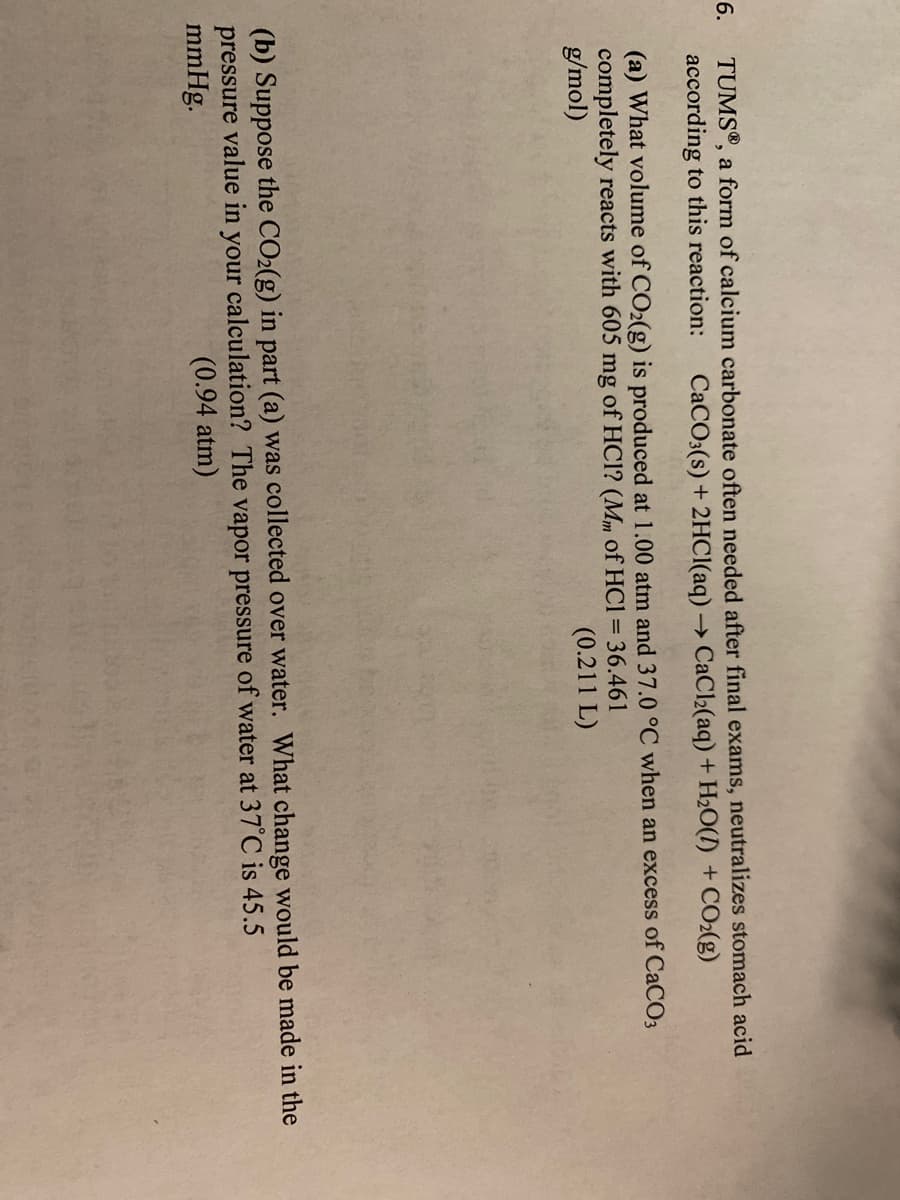TUMS®, a form of calcium carbonate often needed after final exams, neutralizes stomach acid according to this reaction: CaCO3(s) + 2HCI(aq) → CaCl2(aq) + H2O(1) + CO2(g) (a) What volume of CO2(g) is produced at 1.00 atm and 37.0 °C when an excess of CaCO3 completely reacts with 605 mg of HCl? (Mm of HCl = 36.461 g/mol) (0.211 L) (b) Suppose the CO2(g) in part (a) was collected over water. What change would be made in the pressure value in your calculation? The vapor pressure of water at 37°C is 45.5 mmHg. (0.94 atm)
TUMS®, a form of calcium carbonate often needed after final exams, neutralizes stomach acid according to this reaction: CaCO3(s) + 2HCI(aq) → CaCl2(aq) + H2O(1) + CO2(g) (a) What volume of CO2(g) is produced at 1.00 atm and 37.0 °C when an excess of CaCO3 completely reacts with 605 mg of HCl? (Mm of HCl = 36.461 g/mol) (0.211 L) (b) Suppose the CO2(g) in part (a) was collected over water. What change would be made in the pressure value in your calculation? The vapor pressure of water at 37°C is 45.5 mmHg. (0.94 atm)
Introduction to General, Organic and Biochemistry
11th Edition
ISBN:9781285869759
Author:Frederick A. Bettelheim, William H. Brown, Mary K. Campbell, Shawn O. Farrell, Omar Torres
Publisher:Frederick A. Bettelheim, William H. Brown, Mary K. Campbell, Shawn O. Farrell, Omar Torres
Chapter5: Gases, Liquids, And Solids
Section: Chapter Questions
Problem 5.114P: 5-114 Carbon dioxide gas, saturated with water vapor, can be produced by the addition of aqueous...
Related questions
Question

Transcribed Image Text:TUMS®, a form of calcium carbonate often needed after final exams, neutralizes stomach acid
according to this reaction:
6.
CACO3(s) + 2HCI(aq) → CaCl2(aq) + H2O(1) + CO2(g)
(a) What volume of CO2(g) is produced at 1.00 atm and 37.0 °C when an excess of CaCO3
completely reacts with 605 mg of HCl? (Mm of HCl = 36.461
g/mol)
(0.211 L)
(b) Suppose the CO2(g) in part (a) was collected over water. What change would be made in the
pressure value in your calculation? The vapor pressure of water at 37°C is 45.5
mmHg.
(0.94 atm)
Expert Solution
This question has been solved!
Explore an expertly crafted, step-by-step solution for a thorough understanding of key concepts.
This is a popular solution!
Trending now
This is a popular solution!
Step by step
Solved in 2 steps with 2 images

Knowledge Booster
Learn more about
Need a deep-dive on the concept behind this application? Look no further. Learn more about this topic, chemistry and related others by exploring similar questions and additional content below.Recommended textbooks for you

Introduction to General, Organic and Biochemistry
Chemistry
ISBN:
9781285869759
Author:
Frederick A. Bettelheim, William H. Brown, Mary K. Campbell, Shawn O. Farrell, Omar Torres
Publisher:
Cengage Learning

Chemistry: Principles and Reactions
Chemistry
ISBN:
9781305079373
Author:
William L. Masterton, Cecile N. Hurley
Publisher:
Cengage Learning

Chemistry for Engineering Students
Chemistry
ISBN:
9781337398909
Author:
Lawrence S. Brown, Tom Holme
Publisher:
Cengage Learning

Introduction to General, Organic and Biochemistry
Chemistry
ISBN:
9781285869759
Author:
Frederick A. Bettelheim, William H. Brown, Mary K. Campbell, Shawn O. Farrell, Omar Torres
Publisher:
Cengage Learning

Chemistry: Principles and Reactions
Chemistry
ISBN:
9781305079373
Author:
William L. Masterton, Cecile N. Hurley
Publisher:
Cengage Learning

Chemistry for Engineering Students
Chemistry
ISBN:
9781337398909
Author:
Lawrence S. Brown, Tom Holme
Publisher:
Cengage Learning

Chemistry: Principles and Practice
Chemistry
ISBN:
9780534420123
Author:
Daniel L. Reger, Scott R. Goode, David W. Ball, Edward Mercer
Publisher:
Cengage Learning

General Chemistry - Standalone book (MindTap Cour…
Chemistry
ISBN:
9781305580343
Author:
Steven D. Gammon, Ebbing, Darrell Ebbing, Steven D., Darrell; Gammon, Darrell Ebbing; Steven D. Gammon, Darrell D.; Gammon, Ebbing; Steven D. Gammon; Darrell
Publisher:
Cengage Learning

Chemistry: An Atoms First Approach
Chemistry
ISBN:
9781305079243
Author:
Steven S. Zumdahl, Susan A. Zumdahl
Publisher:
Cengage Learning